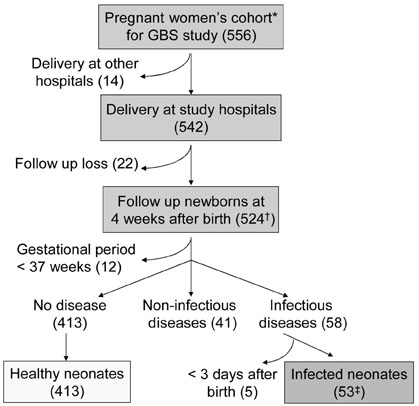Yonsei Med J.
2008 Aug;49(4):530-536. 10.3349/ymj.2008.49.4.530.
Risk Factors for Neonatal Infections in Full-term Babies in South Korea
- Affiliations
-
- 1Department of Pediatrics, Eulji Hospital, Seoul, Korea. kimoran@eulji.ac.kr
- 2Department of Pediatrics, Eulji University, School of Medicine, Daejeon, Korea.
- 3Department of Preventive Medicine, Eulji University, School of Medicine, Daejeon, Korea.
- KMID: 1793187
- DOI: http://doi.org/10.3349/ymj.2008.49.4.530
Abstract
- PURPOSE
Since 1997, private postnatal care facilities (San-hu-jo-ri-won in Korean) have emerged to take the role of the family. As a result, neonates are now exposed to many people and are very vulnerable to infection. However, there has been no study on the influence of postnatal care facilities on neonatal infection. The aim of this study was to determine the risk factors of neonatal infection in full-term babies in Korea. MATERIALS and METHODS: We followed up 556 pregnant women and their babies for 4 weeks after their births at 2 hospitals in Seoul and Daejeon from October 2004 to September 2005. Among 512 full-term babies, 58 had infectious diseases. To determine the risk factors for infection, 53 infected neonates at 4-28 days of life and 413 healthy neonates were compared. RESULTS: The incidence of neonatal infection at 4 to 28 days after birth was 10.5%. After adjusting the related factors, the number of siblings (OR = 2.05, 95% CI = 1.13-3.71 for 1 or more) and postnatal care facilities or home aides (OR = 1.91, 95% CI = 1.07-3.45) were significant risk factors. Formula or mixed feeding (OR = 1.66, 95% CI = 0.91-3.04) increased the risk of neonatal infection but it was not statistically significant. CONCLUSION: When the newborns had siblings, stayed at postnatal care facilities, or were cared for by home aides, the risk of neonatal infections significantly increased. Further research on the feeding effect on neonatal infection and evaluation of prevention efforts are needed.
Keyword
MeSH Terms
Figure
Reference
-
1. Sinha A, Yokoe D, Platt R. Epidemiology of neonatal infections: experience during and after hospitalization. Pediatr Infect Dis J. 2003. 22:244–251.
Article2. Vergnano S, Sharland M, Kazembe P, Mwansambo C, Heath PT. Neonatal sepsis: an international perspective. Arch Dis Child Fetal Neonatal Ed. 2005. 90:F220–F224.
Article3. World Health Organization. Perinatal mortality. A listing of available information. 1996. 4th ed. Geneva: WHO, Maternal Health and Safe Motherhood Programme;(WHO/FRH/MSM/96.7).4. World Health Organization. Neonatal and perinatal mortality: country, regional and global estimates. 2006. Geneva: World Health Organization.5. Stoll BJ. The global impact of neonatal infection. Clin Perinatol. 1997. 24:1–21.
Article6. Guyer B, Hoyert DL, Martin JA, Ventura SJ, MacDorman MF, Strobino DM. Annual summary of vital statistics--1998. Pediatrics. 1999. 104:1229–1246.
Article7. Schelonka RL, Infante AJ. Neonatal immunology. Semin Perinatol. 1998. 22:2–14.
Article8. Hwang NM, Lee IY, Park YT, Seo DW. A study on the management of community postpartum service facilities in Korea. 2001. May. Korea Institute for Health and Social Affairs (KIHASA), Ministry of Health and Welfare;Report No. 2001-28.9. Remington JS, Klein JO, Wilson CB, Baker CJ. Infectious diseases of the fetus and newborn infant. 2006. 6th ed. Philadelphia: Saunders.10. The guidelines for secure management of postpartum care facilities(Sanhujoriwon). 2002. Seoul: The Ministry of Health and Welfare.11. YTN. Ten newborns were infected Gastroenteritis in Sanhujoriwon. 2006. Apr. 13.12. Kim JS, Lee HS, Choi JH, Shin YJ, Koo ML, Kim SS. A study of acute gastroenteritis in neonate transferred from postpartum care centers. Pediatr Infect. 2003. 10:186–192.13. Yoo EK, Ahn YM. A model of community based mother infant care center. J Korean Acad Nurs. 2001. 31:932–947.
Article14. Cunningham AS, Jelliffe DB, Jelliffe EF. Breast-feeding and health in the 1980s: a global epidemiologic review. J Pediatr. 1991. 118:659–666.
Article15. Kramer MS, Kakuma R. Optimal duration of exclusive breastfeeding. Cochrane Database Syst Rev. 2002. (1):CD003517.
Article16. Sinha A, Madden J, Ross-Degnan D, Soumerai S, Platt R. Reduced risk of neonatal respiratory infections among breastfed girls but not boys. Pediatrics. 2003. 112:e303.
Article17. Wranesh BL. The effect of sibling visitation on bacterial colonization rate in neonates. JOGN Nurs. 1982. 11:211–213.18. Umphenour JH. Bacterial colonization in neonates with sibling visitation. JOGN Nurs. 1980. 9:73–75.19. Kowba MD, Schwirian PM. Direct sibling contact and bacterial colonization in newborns. J Obstet Gynecol Neonatal Nurs. 1985. 14:412–417.20. Solheim K, Spellacy C. Sibling visitation: effects on newborn infection rates. J Obstet Gynecol Neonatal Nurs. 1988. 17:43–48.
- Full Text Links
- Actions
-
Cited
- CITED
-
- Close
- Share
- Similar articles
-
- Readmission in Neonatal Period among the Normal Full-term Neonates
- Retinopathy of prematurity-mimicking retinopathy in full-term babies
- Clinical Characteristics of Acute Respiratory Tract Infections in Full-Term Newborns without Risk Factors
- Clinical Characteristics with Risk Factors for Term Neonatal Seizures
- Transiently Evoked Otoacoustic Emission Screening of Neonate


